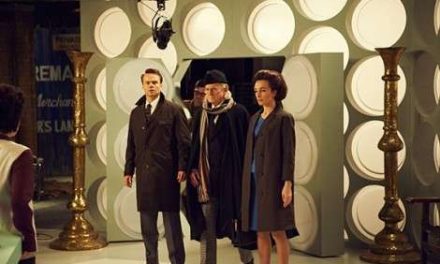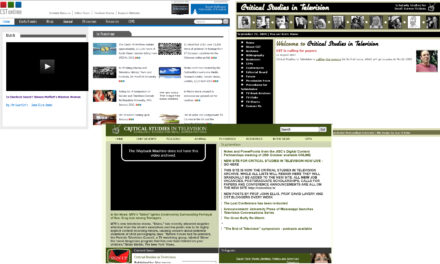On Monday 30 September at 9pm Sky Living launched The Face, a talent-training format based on modelling. One of the three mentors, Naomi Campbell was in New York on launch night. So what is a poor s’leb to do? She books her lunch break for 4pm, slams in a DVD of the show and tweets for an hour as though she was watching the live transmission back in the UK.

This is a vivid example of Stephanie Marriott’s contention that ‘live TV’ is a simulacrum of liveness. But the industry continues to use the term ‘live TV’ to mean “watching the broadcast flow” or sitting there watching when we send the signal (or, at least, as we shall see, doing so on the same evening….). Live TV still matters, at least in the UK, and social media has intensified this relationship. At a Royal Television Society Early Evening Event on scheduling, Neil Mortensen from Thinkbox asked why people are not using Video On Demand (VOD) all the time if it offers a perfectly personalised and convenient form of TV. Mortensen’s interpretation of current data showed that in 2012, the average viewing of live TV was 3 hours 37 minutes; of timeshifted or on demand on the TV it was 24 minutes, and on other devices just 3 minutes. An average of course disguises significant individual and household differences. So he presented the results of a 4 day ‘TV deprivation’ test imposed on some hapless sample families who use VOD as well as broadcast. Deprived first of VOD and then live TV, it was clear that VOD was “like a box of chocolates” but live TV was “like food”. Participant said “I feel kind of cut-off from the world” and “I’m going to have to avoid Facebook for four days”. Social media, it seems, intensifies the experience of live TV through the virtual connections that it offers.
We need to bear this in mind when rushing to embrace the multi-platform vision of TV’s future. The model that US scholars promote may well not be appropriate for other markets where live broadcasting still has a dominant role. It’s doubtful that Campbell’s entourage in New York would really have understood why her simulation of live involvement was so important both to her (it is her first major TV series) and to the success of the series itself. Technological proliferation is intensifying the differences between TV cultures, and many of the key terms of the 1990s debates about the nature of TV in Britain are still relevant today, including the idea of a broadcasting ‘ecology’ and the key role that scheduling plays in the power structure of TV.
Much of the ensuing discussion at the RTS evening was familiar from the late 1990s period that saw scheduling promoted to a key role in the British TV system. I discussed this in Media Culture and Society and Seeing Things. There were the same terms, even including even vivid examples of ‘hammocking’ and ‘inheritance’ from BBC1’s Dan McGolpin, explaining the launch of the new drama Atlantis on Saturday (against ITV’s The X Factor) in terms of its inheritance from Strictly Come Dancingbefore and its lead into Casualty. UKTV’s Steve North pointed out that his schedules for channels like Dave were also developed with reference to “the big boys”, with the difference that quick repeats in a slightly earlier or later slot in the days immediately after first broadcast now generate significant cumulative audience “while the show is still live and fresh and people are still talking about it”. It also broadens the demographic reach. Dara O’Briain’s School of Hard Sums was launched on a Monday at 8pm bringing in a “young, student audience”. The Tuesday repeat at 10.30 brought in “an older, male audience”.

So far, so familiar, then. But the evening also brought new information, especially on the importance of time shifting within one evening, which adds significantly to the all-important overnight figures. There was also a sense that the broadcasting ecology is quite a cosy club, with Sky as the only player in the room holding a few extra cards. One speaker claimed that this cosiness even extends to US schedulers, who, like all schedulers are “passionate about TV”… in the US they even send each other their pilots to look at, apparently. In the UK the cosiness extends to “I’ll show you mine if you show me yours” (it is a rather male environment). Schedule plans are initially released to the press and therefore between the major broadcasters (Sky, not on the platform, was tight-lipped on this, like much else) a week before they are implemented, on a Friday. This offers the press the opportunity to plan coverage and the broadcasters the opportunity for adjustment to avoid the clashes that used to annoy viewers (or at least those who wrote to newspapers) in the old days. A further exchange of schedules between the broadcasters takes place on Tuesday, and a final pass at 1pm on a Wednesday, with everyone’s schedules being locked at 2.30 on Wednesday for the Saturday start. The system works, with the occasional ‘cheat’ being tolerated. BBC1’s Sunday 4 August schedule included a sudden repeat of an edition of Celebrity Mastermind at 7.00. This covered a secret only revealed on Friday, two days after ‘press day’: the surprise live show that launched Malcolm Tucker as the f’ing new Doctor Who.
Scheduling is still at the centre of power in TV. The grid covered in different colours for different genres still guides the commissioning of programming. There was much talk of the planning of supply, “having the right programmes in the pipeline” with even Channel 5’s Craig Morris saying that he was already placing key programmes in the 2015 schedule. Conversely, he revealed that Channel 5’s launch of its first Big Brother series was organised to happen on three consecutive days, with Endemol employing crews for all three days in advance of the Tuesday 1pm decision on which day Morris and his controller would choose. There was also much talk of the way that schedulers are involved in the commissioning conversations with suppliers, hoping to create a happy consensus about the strategy for scheduling a new show. Morris gave an account of when this went wrong: he scheduled Hotel Inspector against Undercover Boss on BBC2, and the producers accused him of “killing their show” on the basis of generic similarity: two business advice shows in the same slot. He claimed to have been vindicated by the substantial figures for Hotel Inspector (which is far from dead and now a Channel 5 staple) and in particular its attraction for the ‘women 35-54’ demographic that was not drawn to Undercover Boss.
The talk of demographics inevitably raised the question of BARB audience data and its reliability. After some self-congratulatory stuff about the UK sample being larger that Neilson’s in the US despite the rather different population sizes, the conversation drifted towards the different data that Sky has about its subscribers. Sky staff revealed that 2 million subscribers report their viewing every other day, and half a million every day. This gives Sky a view of their complex offerings, but also a different set of data on a sizeable segment of the general UK viewership. They keep this information secret, of course. But they were free to reveal the general patterns. Their figures accord with those of BARB for the major channels. They differ in the region of viewerships of 100,000 or less: many of the multi-channels in other words. But they differ in numbers only: “the patterns and the peaks and troughs are largely similar: some channels lost a bit or gained a bit but generally the peaks and troughs were exactly the same”. So there is not, yet, a significant alternative to the view offered by BARB. This matters, since these figures are still the basis of how schedulers build up a picture of their audiences, and hence how controllers, schedulers and producers develop and commission new shows.
You can access the RTS’s own report here.
JOHN ELLIS is Professor of Media Arts at Royal Holloway University of London. He is the author of Documentary: Witness and Self-revelation (Routledge 2011), TV FAQ (IB Tauris 2007), Seeing Things (IB Tauris 2000) and Visible Fictions (1984). Between 1982 and 1999 he was an independent producer of TV documentaries through Large Door Productions, working for Channel 4 and BBC. He is chair of the British Universities Film & Video Council and leads the Royal Holloway team working on EUscreen. His publications can be found HERE.




